FWCM 02: Carlsen's mysterious rook moves!
Karjakin opened the game with 1.e4. Once that move was made we knew for sure that it would be a theoretical battle. Carlsen came excellently prepared. He had done his homework and improved on his game Topalov-Carlsen from Paris Grand Chess Tour. Karjakin was unable to put any pressure on the World Champion and the same story as in round one repeated - White didn't have anything up his sleeve and Black equalized with ease. We have pictures, analysis and key positions for you.
FWCM 2016 02: A draw in the Ruy Lopez
Photos by Albert Silver for ChessBase

Key points in the game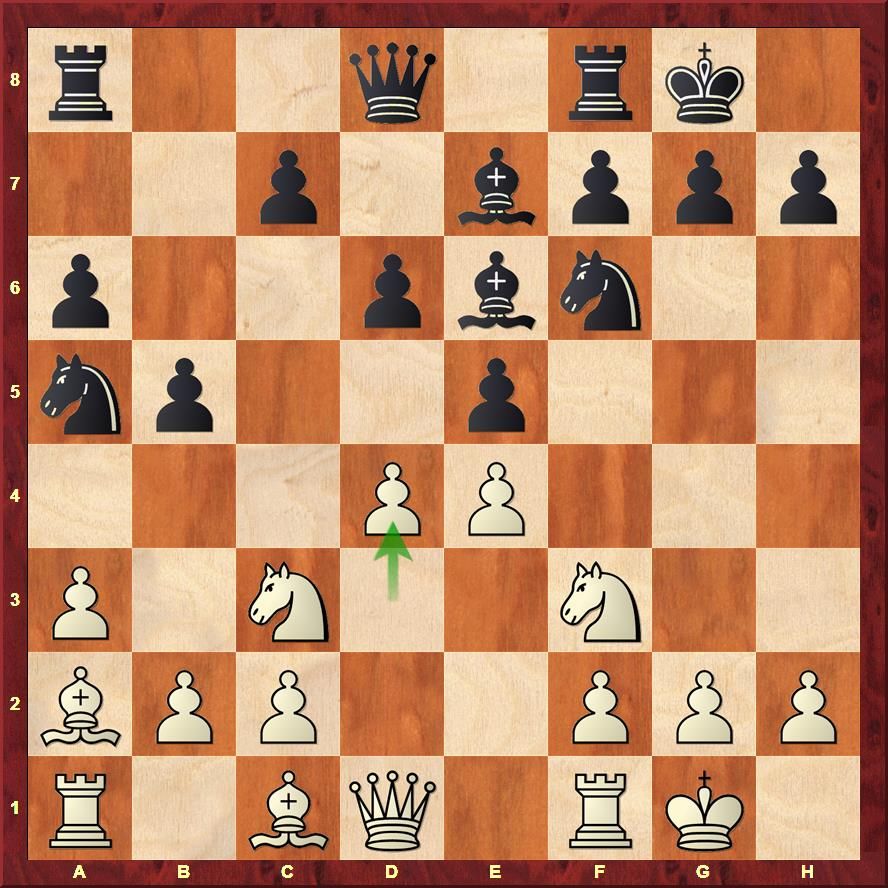
The move d3-d4 had been played in only six games before this one. As GM Vishnu Prasanna, someone who has played this line with white, explains: White's idea is clear he would like to close the position in the future with d5. When Black tries to fight back in the center with c6, then Bg5 will intensify the fight for the d5 square.

This mysterious rook move was Carlsen's big improvement over his own game against Topalov where the World Champion had played ..Nc6. The main idea is to support the e5 pawn, but more importantly the knight doesn't have to go back to c6. Magnus had better plans for it with Nc4-b6 controlling the all important d5 square. 12...Re8 was a very deep move.

The mysterious rook moves keep coming! But this one isn't too mysterious. The idea is clearly prophylactic. Black would like to discourage White from going d4-d5. In that scenario, the rook would be ideally placed on c8 for an opening of the position with c6.

Moves like dxe5 aren't made lightly by world class players. In effect, you are giving up all your space advantage as the pawns on d4 and d6 come off. So Karjakin definitely had to follow it up concretely. As it happened, there was nothing really special that the Russian had and the game was drawn a few moves later.
Analysis by IM Sagar Shah
[Site "New York USA"]
[Date "2016.11.12"]
[Round "2"]
[White "Karjakin, Sergey"]
[Black "Carlsen, Magnus"]
[Result "1/2-1/2"]
[ECO "C84"]
[WhiteElo "2772"]
[BlackElo "2853"]
[Annotator "Sagar Shah"]
[PlyCount "65"]
[EventDate "2016.11.11"]
1. e4 {And there we go! 1.e4 on the board! Contrary to what people used to
feel a few years ago, 1.e4 has now become more of a technical opening thanks
to the Berlin and the solid lines in the Ruy Lopez. Gone are the days when
opening the game with 1.e4 would ensure more attacking games than 1.d4 or the
Reti or the English. But every now and then we have some aggressive games and
our heart cries for such an experience to be repeated!} e5 {Of course, this
was expected. Magnus is not going to be motivated by MVL and play the Najdorf!
Or maybe he will at a later point in the Match! Who knows!?} 2. Nf3 Nc6 3. Bb5
a6 $5 {A pleasant feeling to not see the Berlin.} (3... Nf6 {We have to assume
that Carlsen and co. have also worked on this move and Karjakin and co. have
done their homework. I am sure that the Berlin will be tried in one of the
forthcoming games.}) 4. Ba4 Nf6 5. O-O (5. d3 {While 5.d3 does exist, this is
not particularly a great move because the bishop is still on f8. It gives
Black an option to develop it on g7.} d6 6. O-O g6 $1) 5... Be7 6. d3 {The d3
variations in Ruy Lopez sometimes look boring and dry. But seeing the games of
top players we understand that White is trying to pose micro problems to Black
with this move. Many times Black ends up in a losing position even without
knowing that he has made an error. The reason for this is that when the pawn
structure is symmetrical, it is difficult to generate counterplay for the
inferior side. Hence, the second player must always remain careful.} b5 7. Bb3
d6 {When Black defends his e5 pawn, it is time to think about the b3 bishop,
because now Na5 is going to be threatened. Hence, players generally go for
either a3, a4 or c3.} 8. a3 {This is currently the most popular move at the
top level. Nikolaos Ntirlis in his excellent book Playing e4 e5 - A Classical
repertoire for Black writes, "This is clearly a top-level system, mostly
suitable for positionally-oriented players, as it contains a lot of subtle
nuances and demands careful handling from both players."} O-O (8... Na5 $5 {
According to Ntirlis, this might be the more accurate way to play, as after} 9.
Ba2 c5 10. b4 Nc6 {White has no knight on c3, to immediately jump to d5. Hence,
he must take care of his b4 pawn.}) 9. Nc3 {Many spectators already start to
yawn at this point. The reason: look at the knights of both sides. They are on
identical squares. Look at the central structure. Again identical! Isn't this
going to be dull, drab draw? Well, look at the biggest difference in the
position. The black bishop is on e7 and the white one on b3. This gives him an
edge.} Na5 (9... Be6 $6 10. Nd5 Na5 {And now White has the positional strong}
11. Nxf6+ Bxf6 12. Bxe6 fxe6 13. b4 $1 Nc6 {and with the pawn still on c7,
this is quite bad for Black.} 14. c3 $14 {[%cal Gc1e3,Ga3a4,Gd1c2,Gc3c4] White
has many ideas in this position, while Black is passive.}) 10. Ba2 Be6 {
A lot of moves have been played by White in this position including b4, Bxe6,
Bg5 etc. Karjakin goes for d4.} (10... c5 {is well met with} 11. b4 $1 Nc6 12.
Nd5 $14 {When White once again has a nagging edge.}) 11. d4 $5 {Six games have
been played with this move and the top level encounters are between
Caruana-Aronian and Topalov-Carlsen! So it can be assumed that all this was
quite well know territory for both the players.} Bxa2 12. Rxa2 Re8 $5 (12...
Nc6 {was played by Magnus aginst Topalov. So the Norwegian has a slight
improvement up his sleeve.} 13. d5 Nb8 14. Qe2 Nbd7 15. Rd1 Qc8 16. Nh4 g6 17.
g3 Ne8 18. Ng2 Ng7 19. Bh6 Nf6 20. Ne3 Qh3 21. Bxg7 Kxg7 $11 {0-1 (41) Topalov,
V (2761)-Carlsen,M (2855) Paris 2016}) 13. Ra1 (13. dxe5 dxe5 14. Nxe5 Qxd1 15.
Rxd1 Bd6 16. Nd3 Nxe4 $11 {The pawn is regained and it just equal.}) ({The
only other game that reached this position continued} 13. Qd3 exd4 14. Nxd4 Qd7
15. Bg5 g6 16. f4 c5 17. Nf3 Rad8 18. a4 Nc6 $11 {1/2-1/2 (28) Paravyan,D
(2506)-Harutyunian,T (2426) Moscow 2016}) 13... Nc4 (13... Nc6 14. d5 Nb8 {
is usually the way Magnus likes to play. Get his knight from b8-d7 like in the
Breyer.}) 14. Re1 (14. b3 Nb6 15. dxe5 dxe5 16. Nxe5 Bd6 $11) 14... Rc8 $5 {
Is this one of Nimzowitsch's mysterious rook moves? Aren't rooks supposed to
be placed on open files? Well, there are no open files in this position and
the rook on c8 is ensuring that White doesn't go d4-d5. If White does close
the position with the move d5, then c6 would ensure that the rook remains on
the semi-open c-file.} (14... Bf8 {looked like the normal move. Bg5 is not yet
possible because the pawn on b2 would hang.} 15. b3 Nb6 16. Bg5 {This must be
a position that Magnus didn't like.}) 15. h3 (15. b3 Nb6 16. dxe5 dxe5 17. Qxd8
(17. Nxe5 Qxd1 18. Rxd1 Bd6 19. Nc6 Nxe4 20. Nxe4 Rxe4 21. Be3 {White could
claim a small edge here, but it is almost nothing and with some more accurate
moves, Black can equalize.}) 17... Bxd8 $11) 15... h6 {Both sides are making
some useful moves in the position before committing to anything. Magnus wants
Sergey to take on e5, while the Russian would like the Norwegian to take on d4.
It's cold war and no one is going to budge easily.} 16. b3 Nb6 17. Bb2 Bf8 18.
dxe5 {Karjakin is the first one to give up the central tension. Usually
decisions of such magnitude are not taken lightly by top class players. It is
only if something concrete is found do they like to release the tension. Hence,
in this position dxe5 has to be followed by energetically by White as we shall
see in the game.} (18. a4 b4 19. Na2 exd4 20. Nxd4 c5 $11) 18... dxe5 19. a4 {
This is what Karjakin was banking on, but it wasn't something terribly special.
} (19. Qxd8 Rcxd8 {And here a4 is also possible, but there could be an
interesting manoeuvre.} 20. Na2 $5 {This move attacks the e5 pawn and now
prepares Nb4.} Nfd7 21. Nb4 Ra8 22. Nc6 $14 {One already gets the feeling that
White is pushing in this position.} f6 23. Bc3 {controlling the a5 square.} Nb8
24. Na5 c5 25. Nh4 Rc8 26. Ng6 Nc6 27. Nxc6 Rxc6 28. Ba5 $14 {This
illustrative line just shows how White can keep up the pressure in this
symmetrical position.}) 19... c6 {This is quite typical Magnus' play in the
Ruy Lopez. He likes to make uncommittal moves and release the tension only
when it is the most appropriate for him.} 20. Qxd8 Rcxd8 21. axb5 axb5 22. Ne2
(22. Ra6 Nfd7 (22... Rb8 {is also possible.}) 23. Rea1 f6 24. Ra7 Ra8 $11 {
And the rooks will come off with handshakes all around.}) 22... Bb4 (22... Nxe4
23. Bxe5 (23. Nxe5 $6 Bc5 $1 24. Nd3 Rxd3 25. cxd3 Bxf2+ 26. Kf1 Bxe1 27. dxe4
Bd2 $15) 23... Ng5 $5 24. Nxg5 Rxe5 25. Nf3 Re6 $11) 23. Bc3 Bxc3 24. Nxc3 {
Black has full equality and Magnus makes the draw without any difficulties.}
Nbd7 25. Ra6 Rc8 (25... Re6 26. b4 Rb8 {With the idea of Nb6-c4.} 27. Rea1 Nb6
28. Ne1 Nc4 29. Nd3 {might be something for White to bite on.}) 26. b4 {
Stopping Nc5.} Re6 27. Rb1 c5 {Magnus finds the quickest way to defuse the
position.} 28. Rxe6 fxe6 29. Nxb5 cxb4 30. Rxb4 Rxc2 31. Nd6 Rc1+ 32. Kh2 Rc2
33. Kg1 {This was a great result for team Magnus. White showed no real ideas
in the opening, and Black equalized without any difficulties. It seems as if
Magnus will repeat 3...a6. The ball will be in Karjakin's court.} 1/2-1/2
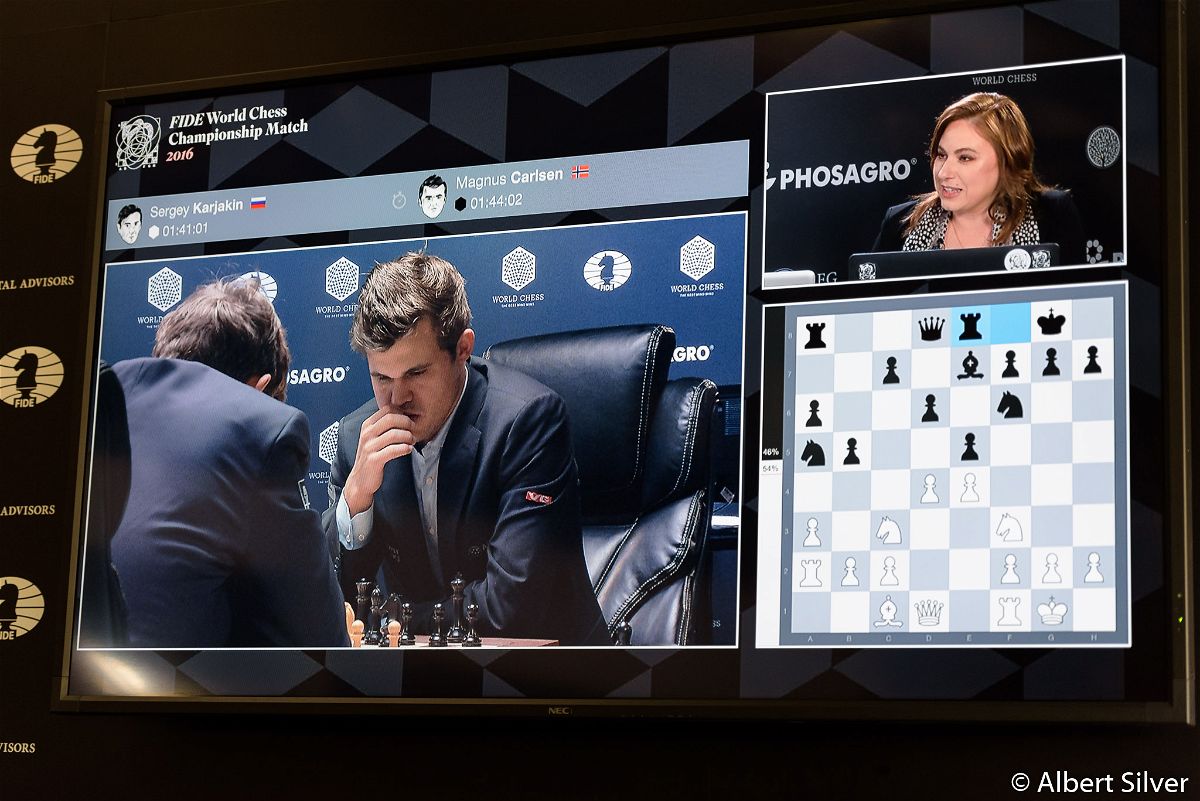

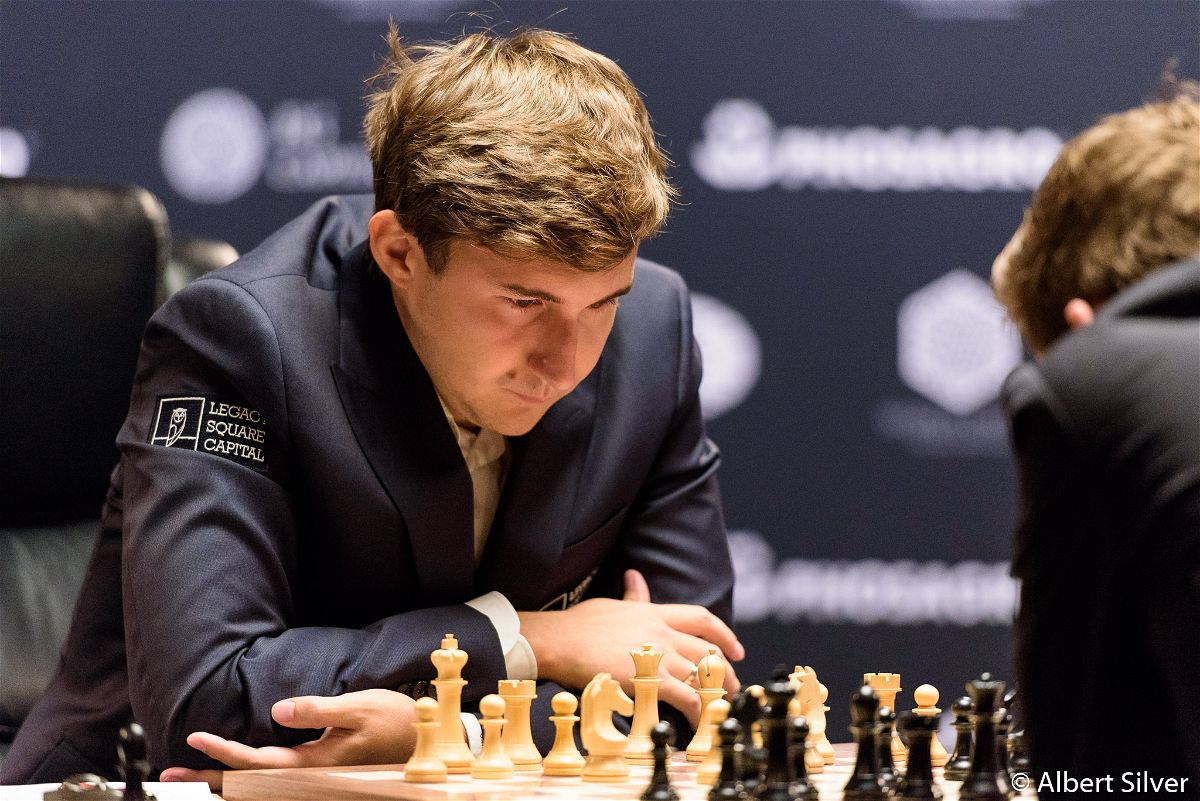
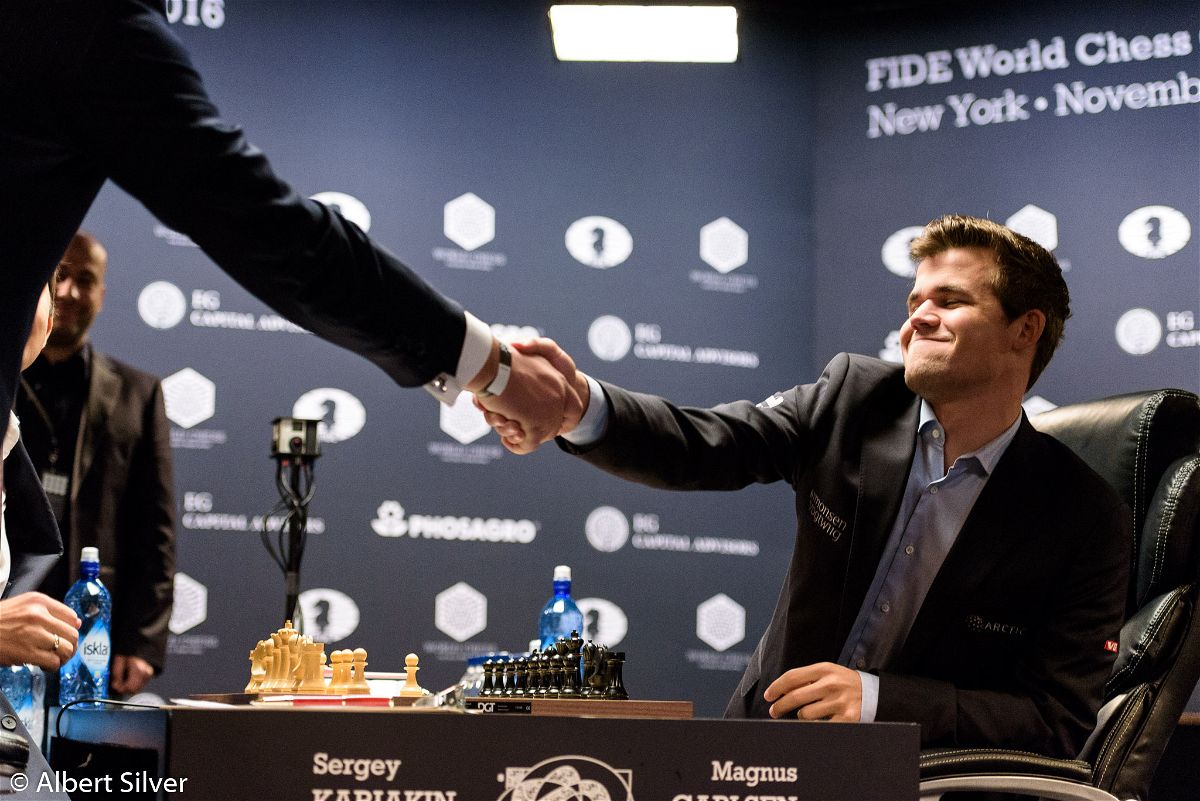
He further added that Karjakin and he aren't friends but just 'colleagues'. Karjakin agreed.
Karjakin also said,"Maybe the games are not so nice at the moment but I believe we will have some fun games. Maybe I didn't play precisely — I thought I was playing in an interesting way."

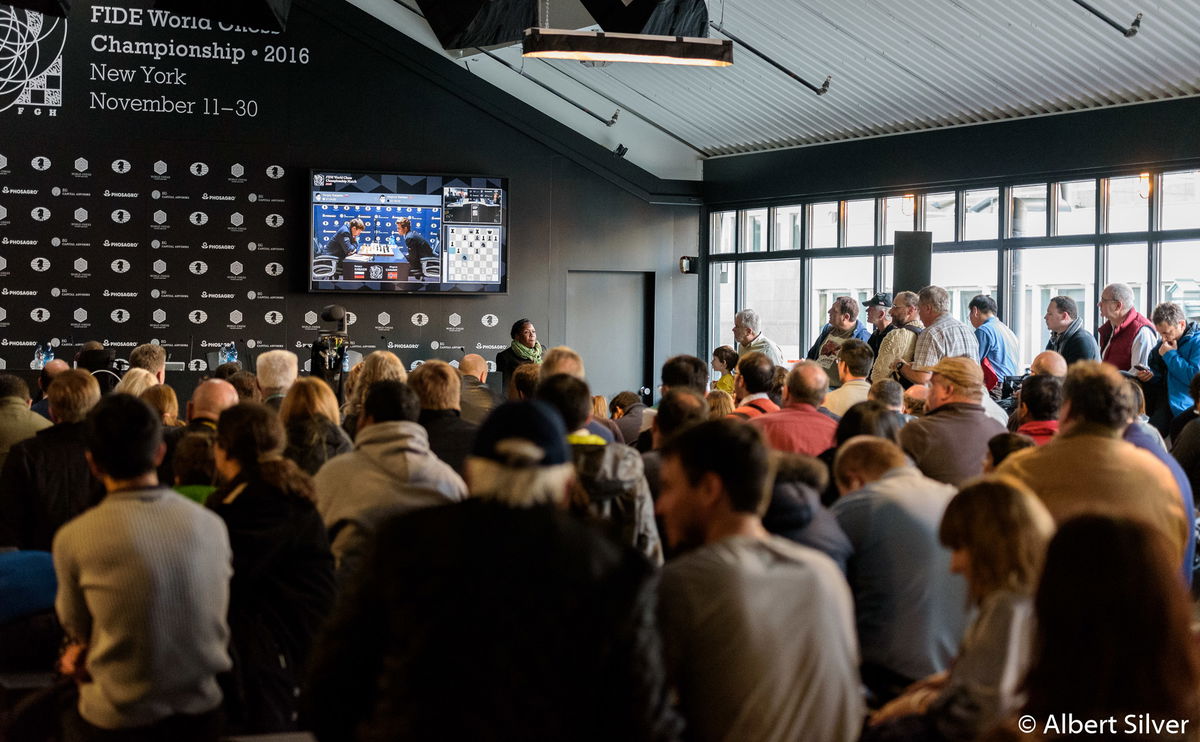

Related:
- FWCM 2016 01: Carlsen's benign Trumpowsky!
- FWCM 2016: Press Conference and Opening Ceremony
- Extensive Report on ChessBase International with analysis by Ruslan Ponomariov!
